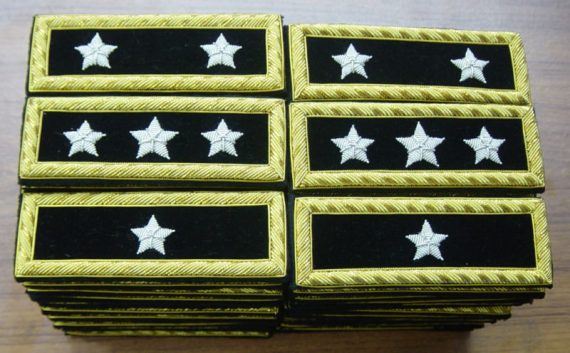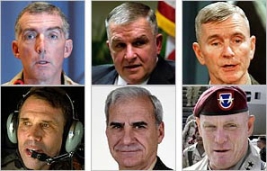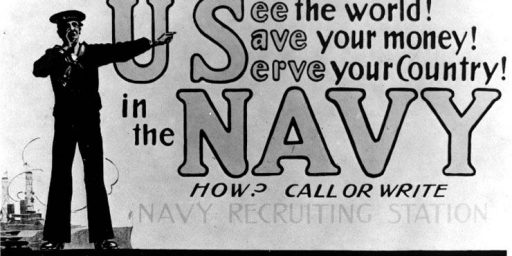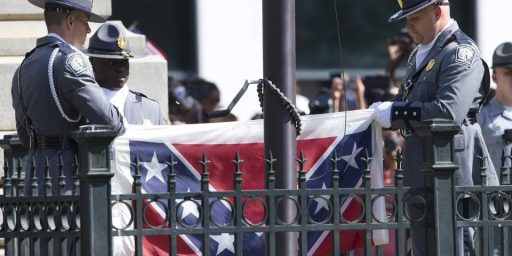Army and Navy Cutting Generals and Admirals Ever So Slightly
The Army and Navy are finally doing something about brass bloat.
The Army and Navy are finally doing something about brass bloat.
Stars and Stripes (“Army, Navy target top brass, headquarters spending in latest cuts“):
With a warning that “the money is gone,” military leaders driven by falling defense spending are moving to cut top brass positions and slash headquarters spending.
The Navy announced late Tuesday that Navy Secretary Ray Mabus had approved a plan to “reduce, eliminate or consolidate a net of 35 Navy flag officer positions” at the one-, two- and three-star ranks. The Navy said it also plans to eliminate 6 more top officer positions in the 2015 budget.
And last week, a memo from Army Chief of Staff Gen. Ray Odierno and Army Secretary John McHugh declared that a plan to cut Army headquarters at the two-star level and above by 25 percent was priority No. 1 for headquarters staff.
The Navy said flag officer end strength is being reduced using a “phased approach” and will be complete by 2017, resulting in 151 Navy-specific billets and 61 flag officers to fill joint billets.
[…]
The Navy released a detailed list of positions to be reduced or eliminated, with most being reduced by one pay grade. For instance, the director of intelligence, surveillance and reconnaissance capabilities in the office of the Chief of Naval Operations at the Pentagon will be a captain in the future, rather than a one-star admiral.
Other positions will be merged, such as two jobs in the CNO’s office – director of the total force programming and manpower management division, and director of military personnel plans and policy division – that will now be done by one rear admiral. Likewise, the Naval Surface Warfare Center and the Naval Undersea Warfare Center, located in Washington, will be commanded by a single one-star.
A few positions will be eliminated, including commander of Submarine Group 2 in Groton, Conn.
The Army memo, dated Aug. 14 and first reported by Defense News, lacks the specificity on cuts that the Navy announcement has. But in terse language punctuated with bold-face type and sentences in all capital letters, it ordered commanders to present plans within two weeks for achieving the 25 percent reduction.
“Let there be no mistake, aggregate reductions WILL TAKE PLACE,” Odierno and McHugh wrote. “The money is gone; our mission now is to determine how best to allocate these cuts while maintaining readiness. We expect Army leaders, military and civilian, to seize this opportunity to re-shape our Army. This effort will take PRIORITY OVER ALL other Headquarters, Department of the Army activities.”
While these are real cuts, it’s worth noting that we’re starting, relative to the size of the force, from an all-time high. Testifying before the Senate Armed Services Committee in September 2011, Ben Freeman noted,
Since the war in Afghanistan began, every branch of the military has increased its general or flag officer ranks, especially their three- and four-star ranks, but the disparities between the branches are surprising. The Army and Marines, which bear the greatest burden in the war on terror,[2] have added far fewer top brass than the Navy and Air Force. In fact, the Navy and Air Force have each added more top brass than the Army and Marines combined, and the Navy and Air Force added this top brass while cutting more than 70,000 enlisted personnel and lower ranking officers. Furthermore, the Air Force has a historically low number of planes per general and the Navy is close to having more admirals than ships for them to command.
This progression towards a more top-heavy force is a burden for taxpayers and military commanders. The cost of officers increases markedly with their rank, so taxpayers are overpaying whenever a general or flag officer is in a position that could be filled by a lower ranking officer. Additionally, some military personnel experts say unnecessarily top-heavy organizations hinder military effectiveness as they slow decision cycles.[3] Former Secretary of Defense Robert Gates said that “in some cases the gap between me and an action officer may be as high as 30 layers,” and this results in a “bureaucracy which has the fine motor skills of a dinosaur.”[4]
[…]
Since World War II ended, the number of general or flag officers per uniformed personnel has been increasing[13]—reaching an all-time high in 2010 of nearly seven general and flag officers per every 10,000 uniformed personnel.[14] This is an increase of more than half a general or flag officer per 10,000 uniformed personnel than when the war in Afghanistan began; one and a half more than when the Cold War ended; and five more than when World War II ended, as Figure 1 shows. There has been a fairly constant increase in the ratio of general and flag officers compared to all other uniformed personnel since the end of the Cold War, even though the military underwent a contraction during the 1990s and an expansion following the onset of the wars in Afghanistan and Iraq.
As of April 2011, there were 964 general and flag officers. By comparison, at the end of the Cold War the U.S. had 1,017 general and flag officers. Thus, there has only been a nominal decrease in general and flag officers even though the number of active duty uniformed personnel has decreased by roughly 28 percent, the Air Force flies 35 percent fewer planes,[15] and the Navy has 46 percent fewer ships in its fleet.[16] In sum, the number of general and flag officers has barely fallen despite double-digit percentage drops in the size of the forces they command.
This trend towards a top-heavy force structure continued during the post-Cold War drawdown from 1991 to 2001. During this time period, the DoD cut just over 600,000 uniformed personnel—a decline of approximately 30 percent—but only 146 general and flag officer positions were eliminated—a decline of less than 15 percent. Thus, the remaining general and flag officers were responsible for commanding far fewer personnel when the war in Afghanistan began, and this trend towards commanding fewer personnel continued even after the conflicts in Afghanistan and Iraq began, as can be seen in Figure 2.
There were 871 general and flag officers when the war in Afghanistan began in 2001, and by April 2011, there were 964.[17] Yet the enlisted ranks have increased at a smaller rate during the conflicts in Iraq and Afghanistan than the growth than general and flag officers. This trend is the opposite of what has occurred in prior major conflicts. This is the first major U.S. conflict in which the military has increased the general and flag officer ranks at a higher rate than all other ranks. From 2001 to April 2011, the DoD added 93 general and flag officers and 47,604 uniformed personnel (17,739 officers and 29,196 enlisted personnel) to its payroll, which amounts to adding one general or flag officer for every 512 uniformed personnel. To put this in perspective, in 2000, the average general or flag officer commanded approximately 1,590 uniformed personnel. In other words, throughout these conflicts the DoD has employed fewer personnel per general or flag officer than it did in peacetime, which is counterintuitive and historically unprecedented.
During peacetime, there are fewer personnel per general or flag officer because a reserve of lower ranks is not as essential as a reserve of top commanders. The latter take much longer to groom than all other personnel, thus the military must have a stable of general and flag officers ready in the event a conflict breaks out to train and command forces in that conflict. This is the U.S. mobilization doctrine, which argues that the numbers of officers should be kept top heavy to provide a pool to lead new formations in time of mobilization.[18] During a conflict, conversely, the number of enlisted, lower-level officers, and civilians should, in theory, increase at a faster rate than the top brass.
This pattern has not held during the wars in Iraq and Afghanistan. During the first several years of these conflicts, from 2001 to 2007, the number of DoD uniformed personnel actually decreased by more than 5,500,[19] while the number of general and flag officers increased by 28. From 2007 through April 2011, the U.S. military added over 13,000 officers and just over 39,000 enlisted personnel for a total increase in uniformed personnel of 52,937, a 3.8 percent increase. During this same period, the total number of general and flag officers increased by 65, a 7 percent increase. Thus, during the current conflicts the growth of the top brass has outpaced the growth of the total uniformed force.
The increase in the very top brass—three- and four-star officers—further illustrates star creep within the DoD. The number of three- and four-star general and flag officers (lieutenant-generals, vice-admirals, generals, and admirals) has increased since the Cold War ended, as depicted in Figure 3. In 1991, there were 157 three- and four-stars.[20] By April 2011, they had swollen to 194—an increase of 24 percent. We have more three- and four-stars now that at any point since the Cold War ended. Since 1991, no DoD personnel group has grown at a faster rate. From 1991 through April 2011, officer ranks shrank by more than 56,000 (19 percent) and enlisted personnel decreased by nearly half a million (30 percent).
[…]
The Marines have the fewest generals and are also the leanest force (but still top heavy compared to historical Marine force compositions), averaging just over four generals for every 10,000 uniformed personnel. At the other end of the spectrum, the Air Force is the most top-heavy branch with almost ten generals for every 10,000 airmen. In other words, the Air Force is two-and-a-half times as top-heavy as the Marines, and in absolute terms they have more than three times as many generals as the Marines. With 312 general officers, the Air Force is tied with the Army for most general and flag officers of any service, even though the Air Force has approximately 237,000 fewer uniformed personnel than the Army.
Now, let’s stipulate that stars-to-troops ratios are not a perfect metric by any means. The proliferation of technology has decreased the need for raw manpower and increased the need for education and training. But, while that would explain a higher ratio of officers to men, it doesn’t explain why we need so many generals and admirals. Nor does it explain the odd phenomenon of the Air Force, the service least impacted by the fighting of the last eleven-plus years, having the highest rate of star creep. Nor, especially, does it explain why jobs done by one-stars a decade ago suddenly need to be done by two-stars.
Three years and three SECDEFs ago, Bob Gates was trying to do something about the problem:
[T]he proliferation of new staff and more layers of bureaucracy is a natural consequence of the substantial increase in the most senior leadership, general and flag officers, career senior executives and political appointees requiring Senate confirmation.
Over the past decade, the department has added to what was already a high historical baseline for senior personnel. For example, since September 2001, the number of general and flag officers has grown by more than a hundred, including now 40 four-star positions. And the number of senior civilian executive positions has increased by more than 300.
As a result of the wars, this department has taken on new missions and responsibilities that have required some of these new senior military and civilian billets.
But apart from meeting these genuine war-related needs, we have also seen an acceleration of what Senator John Glenn more than 20 years ago called “brass creep,” a situation where personnel of higher and higher rank are assigned to do things that could reasonably be handled by personnel of lower rank.
In some cases, this creep is fueled by the desire to increase bureaucratic clout or prestige of a particular service, function or region, rather than reflecting the scope and duties of the job itself. And in a post-9/11 era, when more and more responsibility, including decisions with strategic consequences, is being exercised by more junior officers in theater, the defense department continues to maintain a top-heavy hierarchy that more reflects 20th-century protocols than 21st-century realities.
For example, unlike most other commands, four-star service component headquarters remain in Europe, long after the end of the Cold War and long after the vast majority of their fighting forces have departed.
We need to create a system of fewer, flatter and more agile and responsive structures, where reductions in rank at the top create a virtuous cascading downward and outward. In addition to the number of senior positions, there is also the question of their allocation, and whether our distribution of rank by geography or function reflects the mission — missions and realities our military faces today.
Therefore, I am directing a freeze at FY ’10 levels on the number of senior civilian — of civilian senior executive, general and flag- officer, and PAS positions. Furthermore, a senior task force will assess the number and location of senior positions, be they old or new vintage, as well as the overhead and accoutrements that go with them. I expect the results of this effort by November 1st.
At a minimum, I expect this effort to recommend cutting at least 50 general and flag-officer positions and 150 senior civilian executive positions over the next two years.
These reductions would represent 50 percent of the total growth in senior military and civilian positions since 2000. That’s the minimum.
Instead, while Leon Panetta was brought on for his reputation as a budget wonk, those cuts not only didn’t take place but the brass creep continued. Truthout’s Dina Rasor notes that part of the problem is the excess deference to which high ranking officers are accorded compared to their bureaucratic peers:
I have attended many DoD hearings on Capitol Hill over the years and it has always been darkly humorous to me how the top brass arrive to testify. If the hearing was about a Government Accountability Office (GAO) report on problems of a specific weapon system, the GAO officials, usually about two to three of them, would arrive without fanfare. But when the four-star general would arrive to testify, there would be a great flurry of activity as he walked in the room with several three-star generals, three to four one- and two-star generals and a flurry of lower officers scurrying ahead to set up the presentation and charts. They used to take up the whole first and some of the second row behind the witness table with lots of charts and graphs shuffling around as the great man sat down. It was known on the Hill as the flotilla, and it was actually sad to see full-bird colonels masquerading as chart bunnies for the four star.
As silly as it seemed to many of us in the room, it had an effect on the members of Congress. While most of the members from both parties were always happy to horsewhip top officials, including Cabinet members from other government departments, they have, for the most part, seemed hesitant if not reluctant to submit a three- or four-star general to the same treatment. The generals know how to speak Pentagonese (“We are working the problem on a time multiplex basis”), which makes it sound like they have everything under control while the flotilla behind them shuffle ersatz, complex information up to the general to further confuse and intimidate the members of Congress. Even when a member of Congress pushes back, they are probably wondering how this might look on C-SPAN back in their districts and usually don’t bore down to the real information. Nobody wants to be seen beating up on a distinguished top officer in uniform, even if, in reality, he is just another obfuscating bureaucrat under those stars on his shoulders.
While I don’t hold Rasor’s disdain for the top brass–indeed, come next week I’ll be helping prepare the top cohort of majors to start making the transition to become strategic leaders–I share her unease with the reflexive deference. While our four-star officers are accomplished professionals with decades of service to their country, that’s just as true for those in the Senior Executive Service and equivalent in other agencies. But neither Congress nor the general public treats them as equals. We assume a senior executive at State or Interior is at least partly motivated by institutional goals and petty bureaucratic interests. We assume generals and admirals are motivated solely by the security interests of the nation. Indeed, whatever skepticism we have about defense acquisition programs is directed to private industry and defense contractors, not uniformed leaders.






I watched as post Cold War, post BRAC Air Force shrunk. An interesting phenomenon that occurred in the AF was that Base Commanders went from O-6s to Brig Gen to preserve the GO ranks.
Another favorite tactic is to move decision making up the organization. As that occurs, then the support staff has to increase to support the decision maker increasing the overhead, stretching out the process, and further justifying increased rank. It is a wonderful positive feedback loop.
As for the defense acquisition business (which I live and breathe), there is no real need for GOs to run these big programs. In fact, there is an argument that the churn in leadership that is inherent to GOs is detrimental to the program.
You sure know how to generate page-views.
Liz Cheney got busted for lying by the State of Wyoming…and you are posting about the latest General count? I lament the loss of the Commander in Groton…but…
@C. Clavin: Aside from the fact I study this stuff for a living, I think this issue is more interesting and important to the nation that Liz Cheney’s fishing license. Your mileage may vary.
That darn sequester!
I am reminded of the story I heard when I was assigned at the Pentagon of the brigadier general who was assigned there for the first time. Very impressed with himself, on his first day he found the heavy oaken door to his office on the E ring, opened it and stepped inside.
Where he found a room about 12 feet by 12, with four desks, behind three of which sat brigadier generals. One looked up and exclaimed, “You must be the new guy! Can you type?”
@Donald Sensing: Similar story. Happened to me. Was a new 2LT, flown to Washington to get some urgent coordination on some paperwork (can’t remember what was so damn urgent about it), met an O-6 at about 0730 and was quite amused when he just took the document from me, sat down at his rather tiny desk (I had a bigger one back home) and started typing. In fact, as a 2LT, I felt I was rather a rarity at the Pentagon and treated much more solicitously than I though I would be. First experience hanging out with rank. Also realized I never wanted to be in the Pentagon.
The classic command structure (Brigade, Division, Corps, Army) needs less than 4 generals per 10,000 men. That means half of the flag officers are sitting in staff positions where they are presumably way above the needed paygrade. Alas, for some important military reason, it’s so much more efficient to deactivate a couple divisions and aircraft carriers than retiring 200 generals when you have to save money. You know that because the generals told you so.
Apparently 4 other people agree.
Great post James. We need to trim in this area, and I hope the SecDef can prevail upon the AF to trim also. While I think it can be sold to the general public as a cost issue, it is a major efficiency issue.
Steve
Greetings”
Hopefully this won’t turn into some kind of racist, Islamophobic, sexist, homophobic, pogrom to deny our military services the combat effective multicultural diversity that America needs to survive the 21xt Century.
Something that doesn’t seem to have been mentioned either in the post or comments is that general officers frequently have “pet projects” that they’ll promote all through their careers and, frequently, after them, working for military contractors or suppliers. As circumstances change these projects can have an ever more tenuous relationship with actual defense priorities.
Fewer flag officers means fewer projects being promoted. Flag officers’ and their staffs’ salaries and benefits aren’t the only expense associated with officer bloat.
Those sort of rules are for the little people.
Just a thought, the Senate confirms all military promotions and could put a thumb on the scale. Though as Rasor points out the Senate is not willing to call horse feathers.
Back in the early 1950s CAPT Rickover (O-6, Col in Army) testified before Congressional Committees on the nascent nuclear power program. Today the most junior congressman would be insulted if a mere O-6 was sent to brief them. So now the Action Officers (staff) brief up their bosses to be talking heads when on The Hill. Several times I accompanied my 2-star boss on office visits to Congressmen to provide backup on my program – I stayed quiet unless addressed (had a similar visit to a 4-star – and I was asked more as the subject matter expert, but I was still expected to be quiet). BTW, my $4B project was funded eventually (became a program).
Submarine Group 2 has been on the chopping block for some time. But this position also doubles as the (only) senior Navy officer in the North East. Semi-operational.
I’ve worked for (I think) nine 1-2 stars (Navy and USAF) plus three O-6s that made O-7 (only 3 in DC).
What is needed is to get rid of DC staff positions.